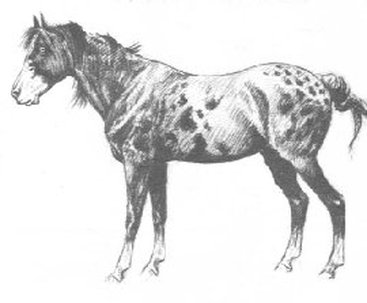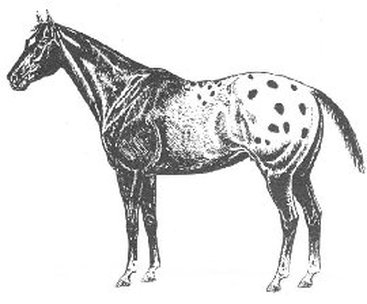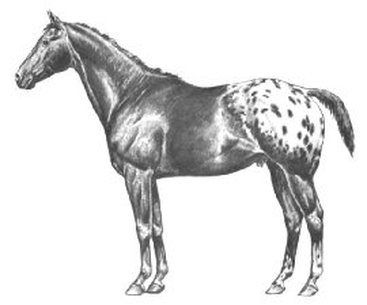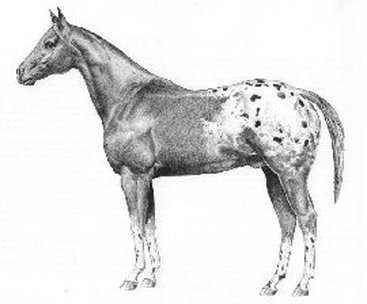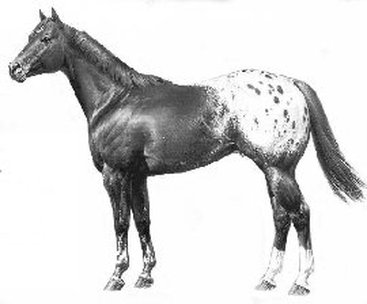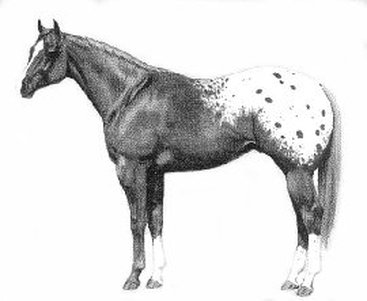THAT APPALOOSA PROFILE
APELUSI BY DAN MULLER-- 1936This image was published in Muller's 204 page book of illustrations and anecdotes entitled "Horses". Although never used by the Appaloosa Horse Club (it was published two years before there was an Appaloosa Horse Club) this drawing is interesting in that it was labeled with the name of the breed-- "Apelusi" -- and that it predated the "famous" Western Horseman article by Dr. Francis Haines (1937) which gave Claude Thompson the inspiration to found the ApHC. Muller describes the Apelusi as an "odd colored pony more or less blue in front and the rest of him white with blue spots- the size of a silver dollar over his rump. Can be found in most Montana-Wyoming Injun camps, and there are quite a few above the border in Western- Canadian Country. Usually has a 'glass' eye. In build, not much different from the average run of Injun pony. Where the white man owns him, and feeds him well, he gets to have size... and 'bottom'."
|
APPALOOSA BY ROLAND WOOD-- 195?This profile of an Appaloosa drawn by Appaloosa breeder Roland Wood was used "semi-officially" in the early Appaloosa News Magazines on the Table of Contents page. It was replaced with the "official" drawing made by Phippen in the early 1960's. Interestingly, this early Appaloosa profile has a body style and neck which is similar to the much later Mixer image, a head similar to the Phippen image, yet has the finest and smallest legs and feet of all of the profiles pictured.This image was sold on ApHC stickers and decals even after the Phippen Appaloosa came into being- an example can be seen in an ApHC ad on the inside back cover of the July 1965 Appaloosa News where the buyer can choose between this image, the Shatka Bearstep "Flying Appaloosa", youth galloping on Appaloosas, and the Phippen image. Several regional clubs advertised with this image well into the 1970's.
|
APPALOOSA BY GEORGE PHIPPEN - 196?This drawing was an official Appaloosa profile commissioned by the Appaloosa Horse Club Board of Directors from renowned Western artist, George Phippen. Phippen reportedly used photographs of early Appaloosa champions, as well as conformation illustrations/ measurements of top Thoroughbreds including Man O' War, to make a composite of the ideal Appaloosa. Palmer Wagner's book "The American Appaloosa Anthlogy" tells that Phippen submitted several drafts to the BOD which were sent back for revision before the final image was approved. This image was used in official ApHC Standards, The Appaloosa News, and in ApHC correspondence until the late 1970's. A 1972 colored version by Merilee appeared on the cover of the paperback volumes of the" Appaloosa Horse Club Stud Book and Registry".
|
APPALOOSA BY S. J. HUBBELL-- 1964R.E. Hawkins and S.J. Hubbell together published a book in 1964 entitled "The Appaloosa- Breed Characteristics and Registration Requirements". This book was approved by ApHC Executive Secretary George Hatley, and was offered for sale through the ApHC in the 1960's- an example again can be seen in the July 1965 Appaloosa News, where an the ApHC advertises "Authoritative Appaloosa Books from your Appaloosa Horse Club, Inc." . The books offered in this ad are Volumes 3, 4, and 5 of the "Appaloosa Horse Club Stud Book and Registry", Francis Haines' "Appaloosa- The Spotted Horse in Art & History", "The Appaloosa- Racing record-Vol 1", and the book this image was printed in. This profile has a frame almost identical to the Phippen Appaloosa above, but with the belly flattened, the hip and stifle fleshed out, slightly finer legs and feet, and a noticeably "cleaner" head and neck. (and longer ears!!)
|
APPALOOSA BY ORREN MIXER -- 1980This image was commissioned by the ApHC Board from famous equine artist Orren Mixer. The Mixer Appaloosa undeniably resembles the Ideal American Quarter Horse, painted by Mixer for the AQHA some years earlier, which is a source of controversy for some who resent the idea of an Appaloosa as "just" a spotted Quarter Horse. Taken part by part, this profile is of a longer horse-- but the length is not in the back, as might be assumed- it actually is from a longer, more angled shoulder. The belly is tucked even more than the Hubbell Appaloosa, and the head shorter- and made to appear even more so by being turned slightly. The hip appears larger- it is longer horizontally, but it is not as deep vertically as the Phippen horse. The croup of the Mixer horse is higher by virtue of a longer gaskin than the Phippen horse-- their hocks sit at an almost identical level. The Mixer Appaloosa, interestingly, has the largest foot and most substantial leg bone of all the profiles pictured.
|
APPALOOSA BY SUANNE WAMSLEY-- 198?This drawing is taken from a series of fourteen drawings of Appaloosa color and pattern representations done by Wamsley for the ApHC. These images appeared in a guide published by the ApHC called "Identifying the Appaloosa". These images also appear on a poster of the same title, which the ApHC currently sends out with promotional literature. This is a more relaxed and slightly "smoother" horse compared to the Mixer Appaloosa, and this horse is "leveled out" (comparing wither height to hip height) by virtue of being drawn with a longer forearm. Otherwise, the general conformation and proportions of the body remain the same as the Mixer Appaloosa. This image has slightly finer legs and feet, and an even smaller head. The neck is longer (particularly its topline) and connects more smoothly to the withers.
|
